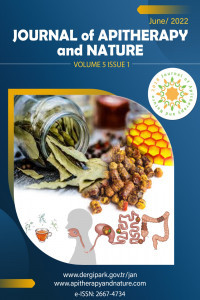What We Know, and Don't Know, about the Benefits of Propolis to Honey Bee Health
What We Know, and Don't Know, about the Benefits of Propolis to Honey Bee Health
Apis mellifera, Honey bee product Propolis,
___
- 1. Simone-Finstrom M, Borba RS, Wilson M, Spivak M (2017) Propolis counteracts some threats to honey bee health. Review. Insects 8: 46 2. Simone-Finstrom M, Spivak M (2010) Propolis and bee health: the natural history and significance of resin use by honey bees. Apidologie 41: 295–311 3. Borba RS, Spivak M (2017) Propolis envelope in Apis mellifera colonies supports honey bees against the pathogen, Paenibacillus larvae. Scientific Reports 7: 11429
- Yayın Aralığı: Yılda 2 Sayı
- Başlangıç: 2018
- Yayıncı: Oktay YILDIZ
GC-MS and UPLCA-PDA-TOF Profile of Polish and Eurasian Propolis
Jarosław WIDELSKI, Piotr OKIŃCZYC, Antoni SZUMNY, Jakub SZPERLIK, Anna KULMA, Zbigniew SROKA, Krystyna SKALICKA-WOŹNIAK, Tomasz MROCZEK
Muhammad IQBAL, Tai-ping FAN, David WATSON, Sameah ALENEZI, Muhamad SAHLAN
What We Know, and Don't Know, about the Benefits of Propolis to Honey Bee Health
Intestinal Morphology Broiler Chickens Supplemented with Propolis
Maja MISKULIN, İvana KLARIC, Matija DOMACINOVIC, Berislav PRAKATUR, Mirela PAVIC, Nika PAVLOVIC, İvan MISKULIN
Portuguese Propolis: A Potenial Source of Environmentally Friendly Fungicides
Catarina PASSÃO, Claudia RODRIGUES, Cristina Almeida AGUIAR, Ana CUNHA
An Overview of Chemical Studies and Biological Activities of Mediterranean Propolis
Konstantia GRAIKOU, İoanna CHINOU
A Collaborative Study for Performance Evaluation of Analytical Methods for Propolis. An IHC Trial
M. LOPES, A. PEREYRA, C. KUNERT, G. BECKH, H. SCHREITER, O. G. ÇELEMLI, K. SORKUN, S GEORGÉ, L. PAULO, S. GARDINI, M.t SANCHO, V. BANKOVA, T. DASTAN, C. TANANAKI, L.f. NUNES, M. VILAS-BOAS
Cytotoxic Activity of Four Propolis Colombian Samples Against Canine Osteosarcoma Cells
Dolly Patricia Pardo MORA, Oscar Julián MURILLO, Mauricio Rey BUITRAGO, Mónica LOSADA, Jaime Fabian Cruz URIBE, Karina Basso SANTIAGO, Bruno José CONTI, José Maurício SFORCIN
Isolated Xanthones from Lisotrigona furva Propolis in Vietnam
Le Nguyen THANH, Ha Thi THOA, Vu Thi Kim OANH, Diep Thi Lan PHUONG, Hoang Thi VAN, Nguyen Quynh CHI, Tran Huu GIAP, Nguyen Thi Tu OANH, Nguyen Thi Minh HANG, Nguyen Van HUNG, Chau Van MINH, Vassya BANKOVA
